The realm of Japanese ukiyo-e art is vast and filled with talents that have shaped the course of art history, yet few have left an enduring mark as profound as Kawase Hasui. Born in 1883, Hasui’s artistic journey is a testament to the beauty of perseverance, innovation, and a deep-rooted connection to the Japanese landscape.
Kawase Hasui: A Brief Background
Kawase Hasui’s early life set the stage for what would become a monumental career in the arts. Born into a merchant family in Tokyo, Hasui’s initial path did not point towards art. Yet, his passion for drawing and painting, sparked in childhood, eventually led him to pursue art against the conventional expectations of his time. This decision marked the beginning of an illustrious journey in the world of ukiyo-e, a traditional form of Japanese woodblock printing.
Artistic Education: The Formation of a Master
Hasui’s artistic education played a crucial role in shaping his unique style. Under the tutelage of Kiyokata Kaburagi, a renowned figure in the art world, Hasui honed his skills and developed a keen eye for landscapes. Kaburagi’s influence is evident in Hasui’s work, which seamlessly blends traditional techniques with a modern sensibility, capturing the transient beauty of Japan’s landscapes.
A Signature Style: Capturing the Essence of Japan
Hasui’s style is distinctive, characterized by its focus on landscapes and the changing seasons. He had a particular affinity for snowscapes, earning him the nickname ‘Snow Artist’ from his contemporaries. Hasui’s ability to depict snow-covered landscapes with intricate detail and atmospheric depth is unparalleled. His work is not just a visual treat but an emotional journey, inviting viewers into serene, snow-laden scenes that evoke a sense of peace and introspection.
Masterpieces of Kawase Hasui
During Hasui’s prolific career he created over 600 prints that captured the essence of Japan’s landscapes. This portfolio spans a range of stunning scenes that showcase his unparalleled ability to capture the mood and atmosphere of a moment. Here are six of the most important artwork of Hasui, each illustrating his mastery of landscape printmaking and his profound connection to the natural beauty of Japan.
Zojoji Temple, Shiba
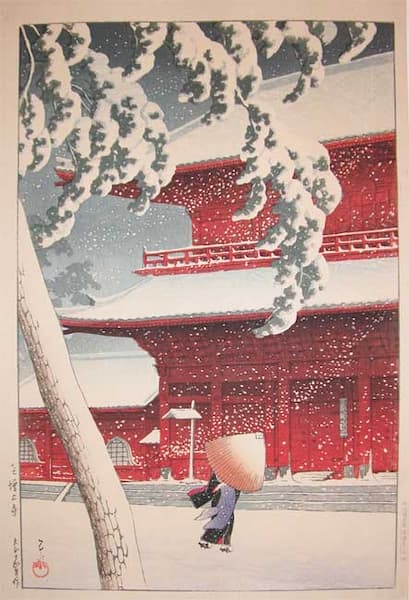
Among Hasui’s extensive portfolio, certain works stand out for their exceptional beauty and technique. One such masterpiece is “Zojoji Temple, Shiba” from the Tokyo Nijukkei series. Created in 1925, this print captures the temple in a snow-covered embrace, reflecting Hasui’s mastery over the depiction of snowy landscapes. The fine gradations of color and the relief on several parts of the paper highlight Hasui’s meticulous attention to detail.
Snow over Zojoji Temple
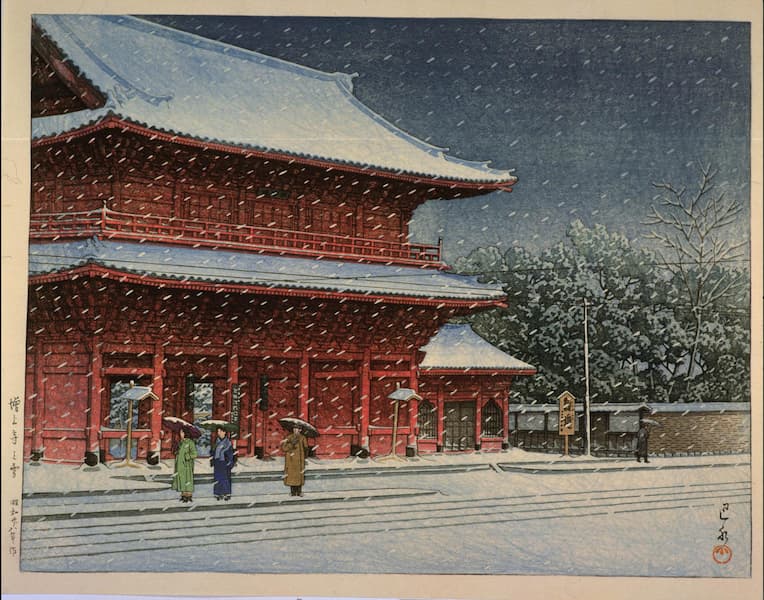
Another notable work is “Snow over Zojoji Temple,” a print created in 1953. This piece, portraying the same temple from a different angle, showcases the evolution of Hasui’s style and the societal changes over twenty-eight years. The contrast between “Zojoji Temple, Shiba” provides a fascinating glimpse into the passage of time, both in the artist’s life and in the world around him.
Evening at Itako, Ibaraki
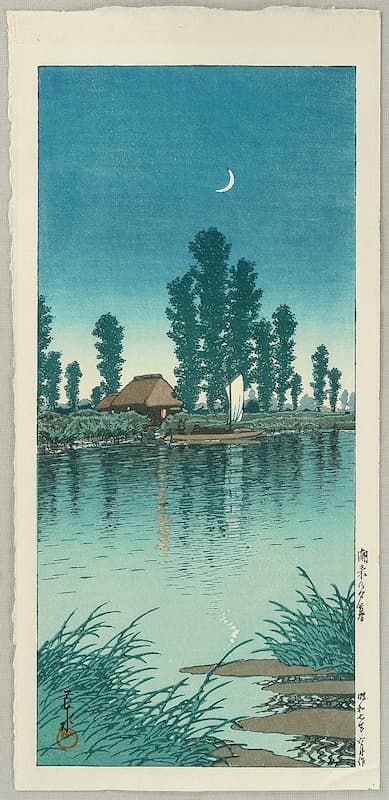
This print, depicting a serene evening scene at Itako in Ibaraki Prefecture, showcases Hasui’s exceptional skill in capturing water reflections and the subtle gradations of twilight. The calm water, reflecting the last vestiges of daylight, and the silhouetted figures crossing the bridge, create a poignant moment of tranquility and reflection. Hasui’s ability to evoke the mood of a fleeting moment is on full display, inviting the viewer into a meditative space that bridges the gap between the tangible and the ethereal.
Rain at Maekawa, Soshu
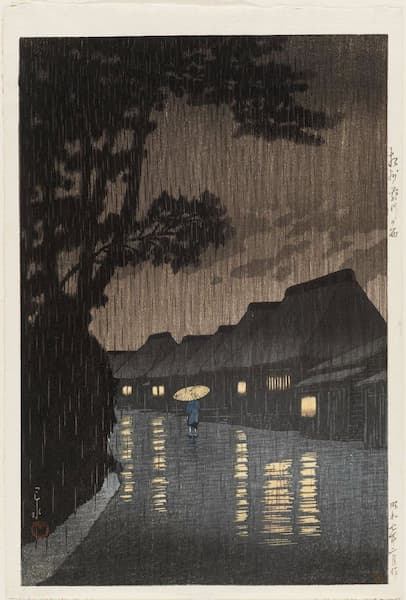
This masterpiece called “Rain at Maekawa, Soshu” exemplifies Hasui’s expertise in depicting rain. The composition focuses on a rural landscape, with the rain adding a layer of depth and dynamism to the scene. Hasui’s use of varying shades of blue and gray to render the rain creates a palpable sense of wetness and the chill of a rainy day in the countryside. This print stands out for its ability to convey the atmosphere of the scene so vividly that one can almost hear the raindrops falling.
Torii Gate at Miyajima
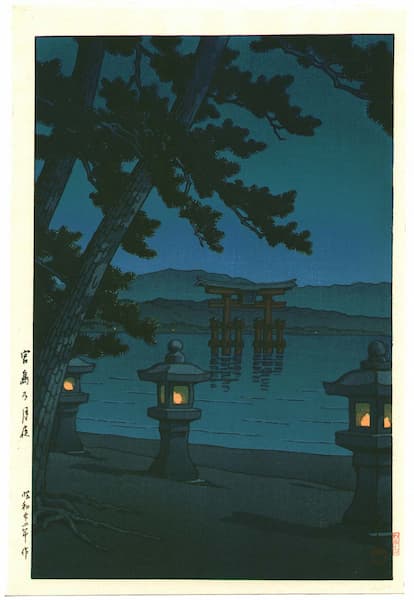
In “Torii Gate at Miyajima,” Hasui captures one of Japan’s most iconic landmarks with a fresh perspective. The print shows the famous torii gate at Itsukushima Shrine at high tide, partially submerged, against the backdrop of a dusky sky. Hasui’s treatment of light and shadow, along with his nuanced color palette, highlights the sacred and majestic aura of the site. This work is a testament to Hasui’s skill in blending natural beauty with cultural significance, offering a window into the spiritual essence of Japan.
Mount Fuji after Snow
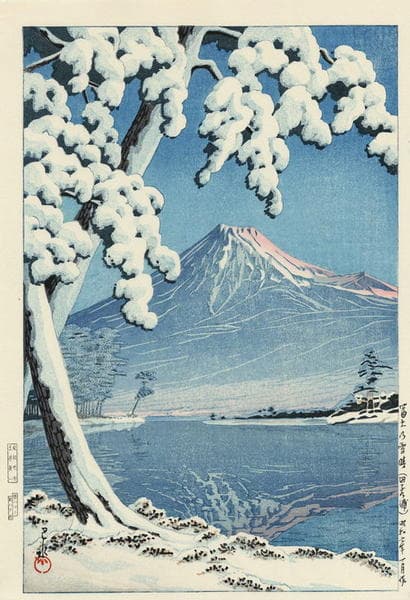
“Mount Fuji after Snow” offers a breathtaking view of Japan’s most revered mountain, covered in a blanket of fresh snow. More importantly, it is a celebration of both the permanence and the ever-changing nature of the landscape. Hasui’s use of contrast between the snow-capped mountain and the clear, crisp sky accentuates Fuji’s majestic presence. The detailed foreground, featuring a small village nestled in the tranquility of the snow-covered landscape, adds a human element to the grandeur, creating a harmonious balance between man and nature.
Mount Fuji continues to be hugely important in Japanese culture and one of the enchanting symbols in Japanese art.
Each of these works, alongside “Zojoji Temple, Shiba,” represents a facet of Hasui’s genius in capturing the essence of Japan’s landscapes. Through his prints, Kawase Hasui invites us to witness the beauty of Japan’s natural and built environments, marked by the changing seasons and the passage of time. His legacy endures in these masterpieces, continuing to enchant and inspire admiration for the delicate balance between humanity and the natural world.
Current Market Prices for Hasui’s Prints
The current market for Kawase Hasui’s original ukiyo-e prints sees a wide range of prices, reflecting the diversity, rarity, and condition of his works. Some examples from various sources include:
- “Moonlight at Seichoen Garden” priced at $597.50 and “Rain at Maekawa” at $975.00, showcasing more accessible options for collectors
- At the higher end, “Chusonji Temple” is listed for $5,800.00 and “Enoshima Island” at $4,300.00, indicating the premium value of certain prints
- A standout piece, “Zojoji Temple in Shiba by Kawase Hasui Pre WWII,” reaches up to $16,000.00, underscoring the significant investment potential of rarer prints
These examples represent just a snapshot of the market, with prices varying based on factors like the print’s edition, historical significance, and condition. For those interested in collecting or investing in Hasui’s prints, it’s clear there’s a broad spectrum of options, from more affordable pieces to significant, high-value works.
Impact and Legacy
Kawase Hasui’s legacy extends far beyond his contributions to the ukiyo-e genre. He played a pivotal role in reviving and modernizing traditional Japanese printmaking, ensuring its place in both national and international art spheres. Hasui’s works are celebrated for their emotional depth, technical precision, and ability to convey the beauty of the Japanese landscape to viewers worldwide. Today, his prints are highly sought after by collectors and continue to inspire artists and enthusiasts alike.
Furthermore, Hasui’s influence is also evident in the recognition he received during his lifetime and posthumously. In 1956, he was designated a Living National Treasure in Japan, a testament to his significant contributions to the cultural heritage of the country. This honor underscores the profound impact Hasui had on the art world and his enduring legacy as a master of the ukiyo-e genre.
Conclusion
Kawase Hasui’s journey from a merchant family to a Living National Treasure is a story of passion, dedication, and a profound connection to the natural world. His works, characterized by serene landscapes and captivating snow scenes, continue to mesmerize audiences, transcending time and space. Finally, Hasui not only mastered the art of ukiyo-e but also expanded its horizons, inviting us all to look closer and find beauty in the fleeting moments of life.
FAQs About Kawase Hasui
What makes Kawase Hasui’s work unique in the realm of ukiyo-e?
Kawase Hasui distinguished himself in the ukiyo-e genre through his masterful depiction of landscapes, particularly snowscapes, which earned him the affectionate moniker “Snow Artist.” His uniqueness lies in his ability to blend traditional Japanese printmaking techniques with a modern sensibility, capturing the evanescent beauty of Japan’s landscapes with an emotional depth and atmospheric precision unseen in the works of his contemporaries. His focus on the subtle gradations of color and light, especially in snowy settings, set his works apart, making them not just artistic renditions but poetic visual narratives.
How did Hasui’s upbringing influence his artistic career?
Hasui’s upbringing in a merchant family initially steered him away from a career in art, pushing him towards more conventional pursuits. However, the creative impulse he nurtured since childhood couldn’t be tamed. This background, a blend of traditional expectations and personal aspirations, fueled his determination to pursue art against the odds. It instilled in him a sense of discipline and a unique perspective on the landscapes he so loved, which later became the hallmark of his artistic expression.
What techniques did Hasui use to achieve the intricate details in his snowscapes?
Hasui employed several traditional techniques unique to Japanese printmaking, along with his innovative methods, to capture the intricate details of his beloved snowscapes. He mastered the use of bokashi, a color gradation technique, to create the soft, diffused edges of snow and sky, which add depth and realism to his scenes. His keen observation and ability to render the subtle shifts in light and shadow through carefully controlled color palettes also played a crucial role in bringing his snow-laden landscapes to life.
What is the significance of the Tokyo Nijukkei series in Hasui’s body of work?
The Tokyo Nijukkei series, translating to “Twenty Views of Tokyo,” is one of Hasui’s most celebrated collections, highlighting his profound connection to the landscapes of Tokyo. Created in the early 20th century, this series captures the essence of Tokyo through different seasons and times of day, offering a nostalgic glimpse into the city’s past landscapes. It stands as a testament to Hasui’s love for his hometown and his exceptional ability to evoke mood and atmosphere, solidifying his status as a master of landscape ukiyo-e.
How has Hasui’s depiction of landscapes influenced modern art?
Hasui’s depiction of landscapes has significantly influenced modern art, particularly in the realms of landscape painting and printmaking. His works transcend cultural and temporal boundaries, offering a universal appeal to the beauty and tranquility of nature. His technique, emphasizing atmospheric effects and emotional depth, has inspired not just artists but also designers and filmmakers, who seek to capture the essence of a place in their creations. Hasui’s legacy encourages artists to observe and portray their environments with a sensitive, evocative approach.
What role did mentorship play in Hasui’s artistic development?
Mentorship played a pivotal role in shaping Hasui’s artistic vision and skills. His most influential mentor, Kiyokata Kaburagi, guided him not only in the technical aspects of painting and printmaking but also in developing a keen observational eye for the beauty of the Japanese landscape. Kaburagi’s emphasis on capturing the fleeting moments of everyday life deeply influenced Hasui, steering him towards the landscapes and seasonal changes that would become the core of his artistic expression. This mentorship was crucial in Hasui’s transition from aspiring artist to master of ukiyo-e.
Read more:
- Collecting Ukiyo-e Art: A Guide for Beginners
- 11 Most Influential Ukiyo-e Artists: Masters of Japanese Woodblock Prints
- The 12 Most Important Ukiyo-e Artworks of All Time
- The Symbolism of Wildly Popular Japanese Woodblock Art
- Art, Mind, and Soul: The Transformative Power of Japanese Ukiyo-e
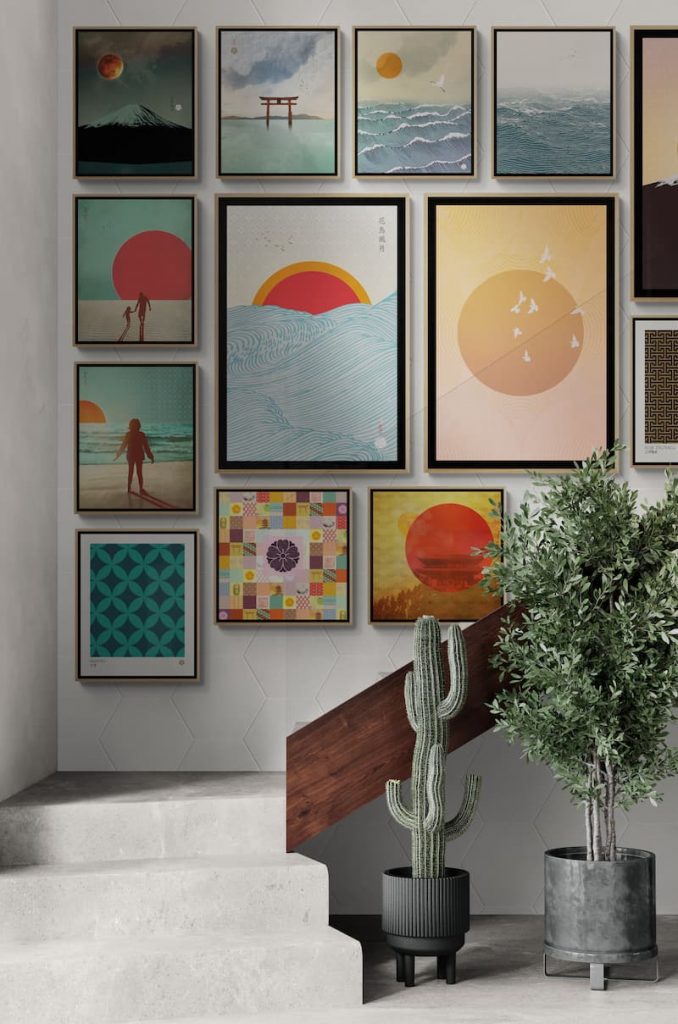
At the Art of Zen we have a selection of original Japanese art prints in the ukiyo-e and Japandi style. Some of our best selling work is Mount Fuji wall art and Japandi wall art.
Add some zen to your space with brilliant original art from the Art of Zen shop.
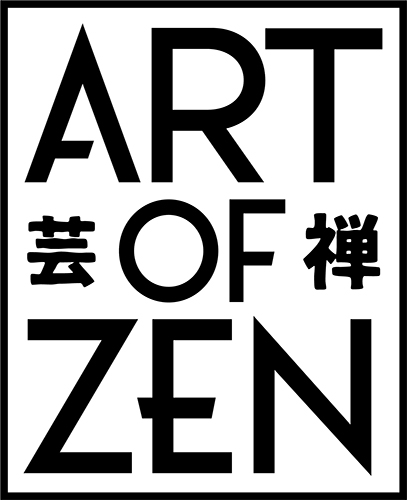
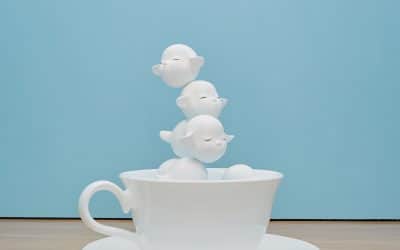
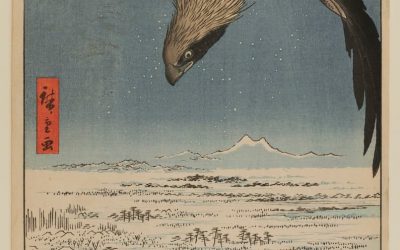

0 Comments